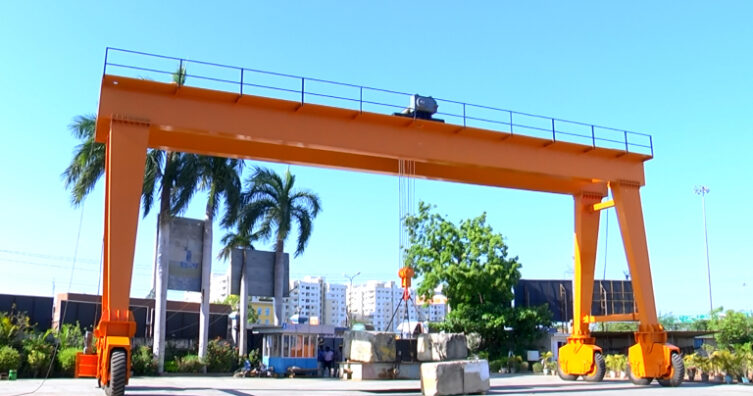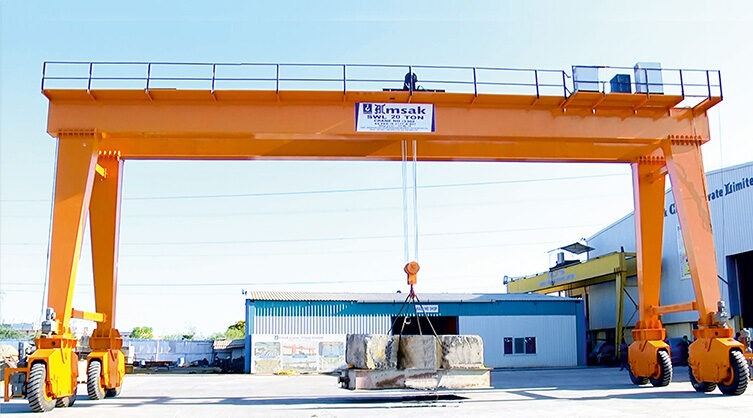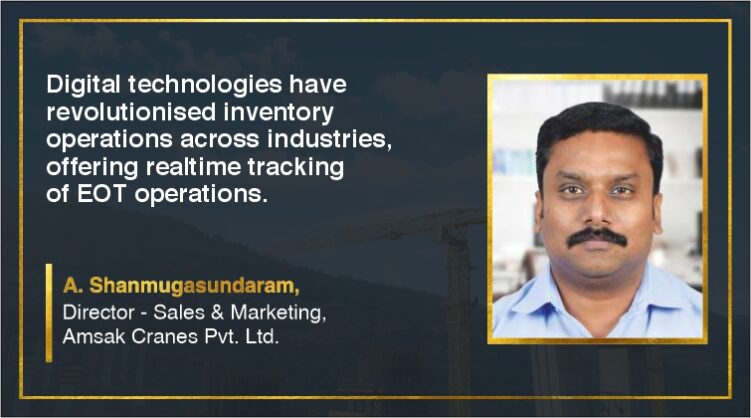Digital technologies have revolutionised inventory operations across industries, offering real-time tracking of EOT operations.
EOT cranes play an essential role in optimising logistics operations by enabling efficient material handling, improving safety measures, providing customisable configurations, and maximising space utilisation, says A. Shanmugasundaram, Director – Sales & Marketing, Amsak Cranes Pvt. Ltd.
How do EOT cranes contribute to cost-effective and streamlined logistics operations?
Electric Overhead Travelling (EOT) cranes are essential for cost-effective and streamlined logistics operations. They offer efficient material handling, increased safety, flexibility, versatility, and optimised space utilisation.
EOT cranes excel in efficient material handling by reliably lifting and transporting heavy loads, reducing manual effort, and boosting productivity. Equipped with safety features like limit switches and overload protection, they prevent accidents and minimise damage to goods, resulting in cost savings.
Their flexibility and versatility are evident in configurations such as single-girder, double-girder, and gantry cranes, allowing customisation to meet specific logistics requirements. EOT cranes adapt to load capacities, traverse paths and operational environments, and optimise resource utilisation.
Mounted on overhead runways, EOT cranes don’t require floor space, ensuring efficient space utilisation. Moving goods vertically and horizontally enables organised stacking, maximising storage capacity and reducing the need for extra storage facilities.
EOT cranes streamline logistics operations through efficient material handling, enhanced safety, adaptable configurations, and space optimisation.
What safety features and regulations govern using EOT cranes in industrial environments?
Safety is paramount in using Electric Overhead Travelling (EOT) cranes within industrial environments. Several safety features and regulations govern their operation, protecting workers, equipment, and materials. Regular inspections and maintenance are essential to ensuring the safe operation of EOT cranes. Industrial regulations typically mandate periodic inspections to assess the crane’s condition, including mechanical components, electrical systems, and safety features. Any necessary repairs or maintenance should be promptly performed to maintain a safe working environment.
EOT cranes often include safety devices for personnel protection. Proximity sensors, laser scanners, or infrared detectors detect the presence of workers in the vicinity and either halt or slow down crane operations, mitigating the risk of accidents.
By adhering to these safety features and regulations, EOT cranes can be operated with proficiency, safeguarding the well-being of workers and the integrity of equipment and materials.

How are technological advancements such as automation and remote control improving the performance and functionality of EOT cranes?
Technological advancements like automation and remote control are transforming EOT cranes, boosting efficiency, safety, precision, flexibility, and monitoring capabilities. It improves efficiency by optimising load movement and reducing delays. Advanced sensors and control systems enable precise positioning, lifting, and transportation, minimising human error. Moreover, remote control enhances safety by reducing direct human involvement in hazardous tasks. Operators can control cranes from a safe distance, while automated safety features and real-time monitoring further enhance safety.
Automation and remote-control technologies provide precise load positioning and movement, benefiting delicate operations and handling sensitive materials. Remote control systems offer flexibility, allowing operators to oversee multiple cranes from a central control room.
Advancements in automation, robotics, and AI present future possibilities for autonomous EOT cranes, offering intelligent navigation, obstacle detection, and complex task execution, further enhancing efficiency and productivity.
What factors should be considered when selecting the right MHE for specific project requirements?
Some key factors need consideration while choosing the right MHE for projects which will help us ensure optimal performance and efficiency. Understanding load characteristics like weight, size, shape, and fragility is crucial to matching the right MHE, such as forklifts or cranes. Evaluating the operational environment, including floor conditions, space availability, and obstacles, ensures safe and efficient operations. Determining the required lifting and travelling capacity involves considering maximum weight and distances. Selecting MHE with adequate capacity and reach is vital for effective performance. Evaluating operational efficiency considers speed, cycle times, throughput, and productivity goals, streamlining operations. Assessing the total cost of ownership, including upfront costs, maintenance, and fuel consumption, helps determine the most suitable equipment. Understanding regulatory and compliance requirements ensure the selected MHE meets the necessary certifications and safety obligations for secure operations.
What maintenance and service requirements should be considered for EOT cranes to ensure their long-term reliability in procurement operations?
Essential maintenence and service requirements must be met to ensure reliable Electric Overhead Travelling (EOT) cranes for procurement operations. Regular inspections assess the crane’s condition, examining the structure, electrical systems, mechanical parts, controls, and safety features. Timely attention to wear, tear, corrosion, misalignment, or damage prevents further deterioration. Proper lubrication of moving parts is vital, following the manufacturer’s recommendations for intervals and types. Regular checks and replenishment maintain optimal performance. Critical brake system maintenance and hoist mechanism maintenance includes regular inspections, adjustments, and testing. Wire ropes, hooks, and sheaves must be checked for wear or damage, replacing worn-out or damaged parts promptly to ensure safe lifting operations.
Safety devices like limit switches, overload protection, emergency stop buttons, and anti-collision systems need regular testing and calibration. Prompt repair or replacement of faulty devices maintains a safe working environment. Proper training and competence of crane operators are essential. Training should cover the crane model, features, controls, safety procedures, and emergency protocols. Regular assessments and updates of operator skills ensure ongoing competence. Adhering to these maintenance and service requirements upholds the reliability of EOT cranes, ensuring smooth procurement operations and a safe work environment.

What innovations are added to this equipment to meet specific procurement needs regarding load capacity, reach, and adaptability to different environments?
Innovations in EOT (Electric Overhead Travelling) cranes continuously meet procurement needs for load capacity, reach, and adaptability. They handle heavier loads through advanced design, materials, and components. Extended reach is achieved with longer girders, larger spans, or telescopic booms, benefiting large-scale facilities. EOT cranes adapt through modular systems, easily modified for different environments and projects.
Advanced control systems enable precise load positioning, optimised movement, and safety features. EOT cranes incorporate innovations for diverse environments, such as corrosion-resistant coatings and components for extreme conditions. Safety enhancements features include collision avoidance, proximity sensors, and real-time monitoring. They also have energy-efficient features like regenerative braking and LED lighting that reduce costs and support sustainability.
Integration with digital systems allows real-time monitoring, predictive maintenance, and optimisation. Remote monitoring and diagnostics ensure quick response times and efficient maintenance. Integration with automation and robotics offers automated load handling, autonomous operations, and robotic attachments. This improves efficiency, safety, and material handling speed. Innovations in EOT cranes continually enhance their capabilities for procurement operations.
For more details, visit: https://amsakcranes.com/
Cookie Consent
We use cookies to personalize your experience. By continuing to visit this website you agree to our Terms & Conditions, Privacy Policy and Cookie Policy.

















